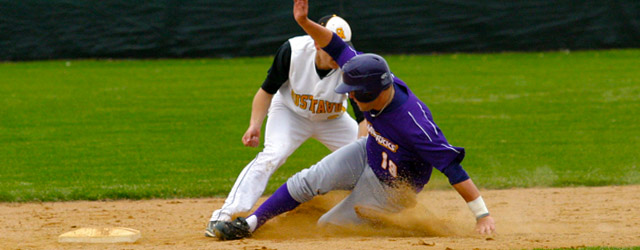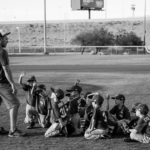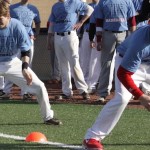Part 1 in a series discussing 1st and 3rd situations.

First and third situations can present a good opportunity for the offensive team to sneak a run across the plate. Double steals, walking leads off of first, and intentional rundowns are just a few of the many ways teams can try to catch the defense off guard. That’s why it’s important to have quality practices that work on first and third situations (and other situational baseball) from the defensive side of the ball. First and third situations are unique in that no matter what play is called, the situation is fluid and the movements of each runner can dictate where the play will be. Today’s post will take a look at one strategy in defending the straight steal of 2nd base, and future posts will examine other defensive strategies.
Offensive Strategy – Straight Steal of 2nd Base
When the offensive team calls a basic steal of second base, they are usually trying to accomplish one of two things. Either they are trying to stay out of the double play by getting the runner from first base to second base, or they are attempting to draw the catcher’s throw to second base in hopes of giving the runner on third a better chance at scoring.
Throw Through to 2nd
As a coach, you’ll want to call this play when getting the out at second is more important than preventing the runner on third from scoring. Usually, you are winning by 2 or more runs and need an out. Furthermore, your catcher has a strong arm and has the ability to throw the runner out. Obviously, we do not want the runner on third to score, but our primary goal is to catch the runner stealing second.
Catcher and 3rd Baseman Responsibilities
When the catcher pops up to throw down to second, he needs to make a quick check on the runner at third. Some coaches teach their catcher to read the runner by determining if his shoulders are squared toward home plate or if he is a certain distance away from third. This is difficult to do considering the catcher has only a split second to make a decision before throwing down to second to get the runner from first. Instead, the catcher should look for his 3rd baseman to help him make the call easier. If the 3rd baseman sees that the runner is too far from the bag, is breaking toward home, or otherwise is caught in the base path, he can raise his arms to notify the catcher to make a snap throw to third instead of down to second base.
The catcher should be able to pick up his 3rd baseman more quickly than trying to read the runner’s intentions. The 3rd baseman should not raise his arms if there is no threat of the runner on third trying to take home. After the catcher makes his quick look to third and sees there is no call from the 3rd baseman, he needs to make his throw down to second base.
Middle Infielders’ Responsibilities
Before the pitch, the shortstop and 2nd baseman should have already determined coverage during a steal attempt. For our purposes, let’s say the shortstop is covering second base on the steal. The catcher has already made his throw down, and the play is to tag the runner out attempting to steal second base. The shortstop’s main priority is to make the tag on the runner. Even though we do not want the run to score, the main priority is to get the out at second. We are essentially trading the run for an out.
During the play, the second baseman needs to be the eyes and ears for the shortstop. If the runner at second got a great jump or there is no chance at tagging the runner out, the second baseman needs to let the shortstop know if the runner on 3rd has broke for home. If this is the case, the shortstop needs to make the quick adjustment and throw the ball home.
Pitcher’s Responsibility
After delivering the pitch, the pitcher needs to make sure he is out of the way of the throw from the catcher. From there, he needs to assess the situation. If the runner attempting to steal second is caught in a rundown, he needs to back up the first baseman and get involved in the rundown. If the play comes back toward home, then he needs to back up the catcher in case there is a rundown between 3rd and home. (We will discuss 1st and 3rd rundowns in a future post.)
Get the Out!
Remember, you want to throw through to 2nd base when the out is more important than the run. Make sure your team is aware of this fact. The ideal situation would have the play end with the runner at second out on the tag and the other runner still standing on third. By no means do we want the run to score and the runner on second to be safe. One way or another, get an out!







2 responses to “Defending 1st and 3rd Situations – Throwing to 2nd”
[…] Defending 1st & 3rd Situations: Throwing to the ShortstopBy Phil TognettiPosted in: Coaching, Fielding Part 2 in a series discussing 1st and 3rd situations. For Part 1, click here. […]
[…] Coaching, Fielding Part 3 in a series discussing 1st and 3rd situations. Make sure to check out Part 1 and Part 2 as […]